Passing Through – The Scilly Isles
(2,300 words)
There is no closer bond than the one between the singlehanded sailor and his boat – until he rows ashore, that is. Then he wants to be joined at the hip to his dinghy.
Mine was on the beach at The Gugh, the smallest and least-populated island of the Scilly Isles – that charming archipelago off the south-west tip of England. To say The Gugh is small is to say that it measures half a mile by less than a quarter. To say that it is the least-populated is also accurate: It has two houses. One is empty and the other is home to a man called Alan – and thank heavens for that…
Mind you, The Gugh is only an island at high tide. The rest of the time, it is joined to the much larger island of St Agnes by a narrow sand bar. This means that it is easy to think of them as one island.
That is a mistake. I went to look at The Gugh and its prehistoric standing stone and two peculiar houses with the curved roofs (so they don’t blow off). Then I planned to go and look at St Agnes which is twice the size and with a population of more than 80. This means that I left the dinghy on the Gugh side…
I did pull it up well above the tide line, I tied it to a rock … with three or four other rocks holding down the first rock … and then another couple in the dinghy itself to stop it flying away. Believe me, that dinghy wasn’t going anywhere.
And so, without a care in the world, I set off for The Old Man of Gugh and Obadiah’s Barrow (where they found a skeleton buried in the sitting position surrounded by a dozen urns full of human remains).
St Agnes was much more cheerful. For a start, it had the Troy Town Maze. Now, I don’t know what sort of image this conjures for you but surely something involving theme parks or stately homes: Certainly a major “visitor attraction”. According to the guide book, it was laid out by a lighthousekeeper in 1729, adding to a much earlier maze. That one may even have had Viking connections since similar designs have been found in Sweden. However, now we’ll never know because in the early 2000’s a well-intentioned visitor took it upon themselves to rebuild the maze with new stones from the beach – thus completely thwarting the archaeologists’ attempts to date it.
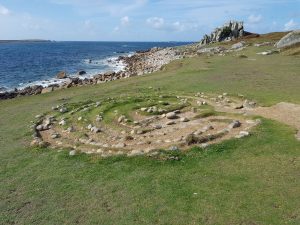
Troytown Maze
Actually, when you see it, you can’t blame the helpful visitor. This has to be the most unimpressive maze ever to make it into a guidebook – even if walking around it is said to promote well-being.
Ha! (see below).
Still, if I hadn’t gone looking for the maze, I would never have found Troytown Farm Ice Cream which has to be absolutely the best anywhere – made from milk from Scilly’s only dairy herd (11 cows).
So, what with one thing and another, it was a contented old man who dawdled back picking blackberries and wondering if you could make crumble with cooking oil instead of butter. That was why it was quite late by the time I returned to the sand bar and the dinghy.
Except, the sand bar wasn’t there any more. Now there was only a maelstrom of churning white water as the spring tide raced between the islands at upwards of four knots. As the guidebook says, helpfully: “It is dangerous to attempt the crossing at such times.”
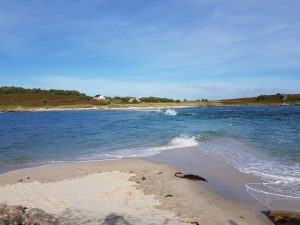
Over on the other side, the water was lapping at my dinghy. Instantly, the singlehander’s primal urge kicked in: Surely, if I went to rescue it now – before the tide came up any higher… I bet I could walk across. It would only be knee-deep… perhaps thigh-deep – but I didn’t mind getting my shorts wet. Even if it was waist-deep…
There must be some medical term for this instinctive rejection of all common sense.
Fortunately, the prospect of drowning acted as an antidote – or rather, drowning and being described in the local paper as “a pensioner” – not to mention the lifeboat coxswain’s comment about “weekend sailors”.
With considerable effort, I hauled myself back from the brink and made for the pub. If in doubt, make for the pub.
Simon, the landlord, listened sympathetically as if he had heard this before (which he had – many times). He and Angela had been corporate IT geeks until they sailed here in their 35footer four years ago and found The Turk’s Head looking for new owners. Simon put all the other customers on hold while he searched for a phone number for “Alan”. I hoped Alan would be at home. Of course, he was at home – where else could he go at high tide? He promised to have a look.
After that, there was really nothing for me to do but sit in the pub for the next four hours while the tide finished coming in and started going out. So I had a beer – and then another beer – that took twenty minutes. Then Simon showed me all the artefacts he had brought up from wrecks around the islands – can you imagine an entire cargo of bells, the sort that summoned the servants in Victorian households?
After that, it seemed to be time for another beer – and, considering the way the evening was panning out, I had better have dinner and was joined by a couple from Devon who were similarly marooned. The Scillonian, the Scilly Isles ferry from Penzance, had suffered double engine failure. People were having to bunk up where they could.
As for me, I rushed back to reclaim my dinghy as soon as I could without drowning. Shame – had I obeyed my usual instinct and stayed in the pub until chucking-out time, I would have been there to join the celebrations at the safe arrival of Safe Arrival, another Rival 32 like Samsara. Her crew of three lads from Falmouth had sailed straight from Greenland – 16 days – at the end of a four-month climbing cruise. Angela broke out the rum.
These guys deserved it. They had been by far the smallest boat in those northern waters – and almost all the others had been steel and aluminium and kitted out for “expedition sailing”. Safe Arrival’s only modifications were a solid sprayhood and a couple of windsurfer masts for pushing the bergy bits out of the way.

But then The Cove at St Agnes seemed to be a gathering place for all sorts of interesting boats. There was an ancient lugger with a bumpkin sticking out the back which must have been half the length of the rest of the boat at least. They hung the ensign off the end of it – with a lead weight to hold it down.
Then there was the brand new Rustler 57 I mentioned in the “Experts” post – but I wasn’t in their league. However, I had already made a friend of the Frenchman in the peculiar catamaran with a mast on each hull. I had anchored rather too close to him in Tresco and then drew even closer as I went to move the next morning.
“Don’t worry, I am here,” he had said as he stood by to fend off. Now, here he was again – and, whatever you think of big cats, his boat was something really special.
Marc had been around multihulls all his life – building them, designing them, sailing them. They’d all been called Kalim – ever since his first when he sailed the Atlantic as a young man to sit at the feet of his heroes, Dick Newick and Mike Birch. In the end, he spent most of his life out there refining multihull design.
Now, with Marielle, he has his ultimate boat – as he put it, his “Old Man’s Boat” – simple, spacious, light and fast – designed for sailing in the tropics and, actually, very beautiful.
How fast would she go with her two wing sails?
At 15metres overall, her designed top speed is 24 knots but that’s not important. What matters is the average and the latest Kalim is designed for daily runs of 200 miles – which means the Galapagos to the Marquesas in not much over two weeks … while the crew relax on the park bench. Yes, they have a park bench at the back of the cockpit in the sun.
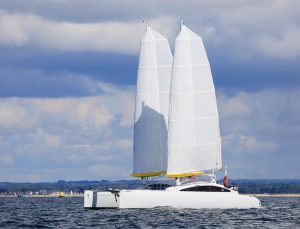
Le Kalim.
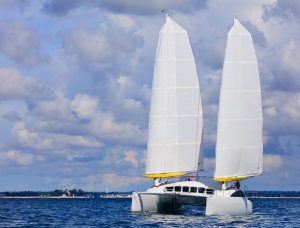
Le Kalim.
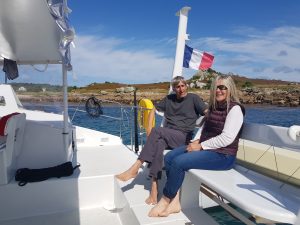
If you fancy a Kalim yourself. You’re out of luck. For the first time, Marc’s design is not for sale. As he said: “As soon as you start selling your ideas, you have people wanting to know where they can put a second head or a washing machine… I’m done with all that…”
He doesn’t even have an outboard – instead, a slender rowing skiff he designed himself. Marc likes rowing – doing it properly with crossed hands.
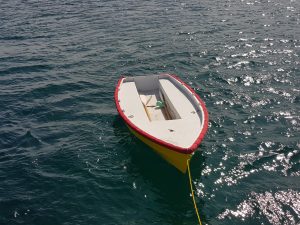
The Scillies were always going to be full of interest – if only because of the anticipation: I had been trying to get here for forty years. The trouble was that the pilot books made the islands sound so terrifying that I ended up sitting in Falmouth or Penzance listening to shipping forecasts and biting my nails. Writers of pilot books love this sort of thing. Even Reeds, not given to hyperbole, says: “The Isles of Scilly are exposed to Atlantic swell and wind. Weather can be unpredictable and fast-changing. Thorough planning and sensible precautions especially with regard to anchorage and ground tackle are recommended. Boats have been known to drag on fine sand…” There follows a whole column of dangers to avoid.
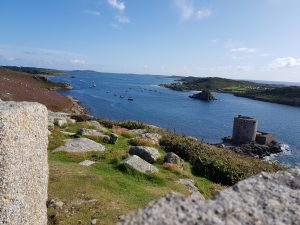
New Grimsby Sound from King Charles’ Castle, Tresco
The first time I came here was on the old Scillonian in 1965 as a 16-year-old biology student on a field trip. Mostly I remember the New Inn on Tresco where I ordered my first pint of beer (my father would only buy me halves, saying that no Gentleman would be seen with a pint). We stayed in a bothy and were served fiery curries by an old sailor who dropped ash into the pot from the Capstan Full Strength glued to his lower lip.
Obviously, I had to go back to the New Inn. But, it’s all changed now: The old bar was demolished in 1997 – conveniently just as a German cargo ship on autopilot hit the rocks off Newfoundland Point while the crew were asleep. It was loaded with wood and, in the best traditions of the Scilly Isles, the islanders helped themselves. The new, extended and wood-panelled bar looks lovely.
Don’t criticise: As the Rev John Troutbeck, 18th Century vicar of St Mary’s, put it: “We pray thee, Lord, not that wrecks should happen but that if any wrecks should happen, Thou will guide them into the Scilly Isles for the benefit of the inhabitants.”
Shipwrecks and the Scillies go together like crab and mayonnaise. In the Abbey Gardens, you can find a museum of figureheads retrieved from the sea – and of course, it was the Scillies where Admiral Sir Cloudesley Shovell’s fleet piled up in 1707, prompting the race to find a way of determining longitude.
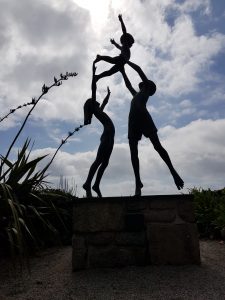
Sculpture, The Tresco Children in the Abbey Gardens
As a 16-year-old, I couldn’t see the point in spending good beer money looking at exotic plants and museums but I do remember looking longingly across New Grimsby Sound and wishing I had a boat. For there was Bryher – as tantalising as a tropic isle on the other side of a sparkling lagoon.
Actually, Bryher is well worth visiting anyway – if only for “the smallest museum in Britain”. It’s probably the smallest museum in the world. It’s the old phone box and is dedicated entirely to the 1989 film When the Whales Came based on the book by Michael Morpurgo. The best part of the story is that, having signed Paul Schofield and Helen Mirren for the leads, the director needed a child to play the central character. After scouring the mainland stage schools, he found her on St Agnes.
All the island people had been recruited as extras – simpler than trying to find accommodation for outsiders. One of those extras was eight-year-old Helen Pearce. All she had to do was play herself – a half-wild nymph of the sea and sand. The critics loved her.
Over on the other side was the Hell Bay Hotel. I mean, you just have to go and have a beer in somewhere called the Hell Bay Hotel. It’s not actually in Hell Bay as such. As the barman explained, there wouldn’t be much left standing after the winter gales – and the guests didn’t look the type to rough it. In my shorts and crocs, I took my beer onto the terrace.
So, out of Scilly’s five inhabited islands, that left only St Martin’s and St Mary’s (I wasn’t going to start on the 50 uninhabited ones.)
I got lost on St Martin’s trying to work out the difference between Higher Town, Middle Town and Lower Town, not to mention Lower Town Quay and Higher Town New Quay and Higher Town Old Quay. Signposts would have helped.
St Mary’s has lots of signposts. It needs them because the typical St Mary’s visitors are devoted couples of a certain age who walk slowly from one commemorative bench to the next where they sit down once more to admire a slightly different view.
Maybe that was why the 1970’s Prime Minister Harold Wilson liked it so much – you can imagine him sitting there puffing his pipe with Mary beside him, making up her poems. He’s buried in the churchyard now – among all the poor, dead sailors.
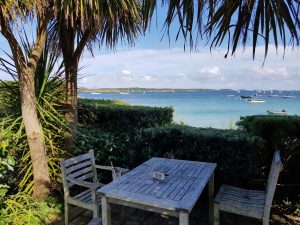

Brilliant. Thank you. Happy memories of sailing (motoring actually) across from Dunmore East across a mercurial sea and anchoring early morning in Grimsby sound below the castle. Customs man came along and after circling announced he was coming about our 30ft converted Buckie boat. After a silent search he announced it was a rascal of a boat in which you could easily hide a ton of “stuff”. She weighed 13 tons! And then proceeded to become our best friend. He’d been posted there from Liverpool and had a young family and never wanted to leave. I wonder if he stayed in his island paradise?
So, another Rival Rally, this time on the Scillies! I’ll have to take Contender there some day – but remember where to park my dinghy!